How to Grow Lettuce
This post may contain affiliate links, which means that I may receive a commission if you make a purchase using these links. As an Amazon Associate I earn from qualifying purchases.
Lettuce is the ultimate garden crop! It is fast-growing, high yielding, and low-maintenance. There are hundreds of varieties, colors, and leaf shapes to keep your salads interesting. Learn how to grow lettuce with these tips.
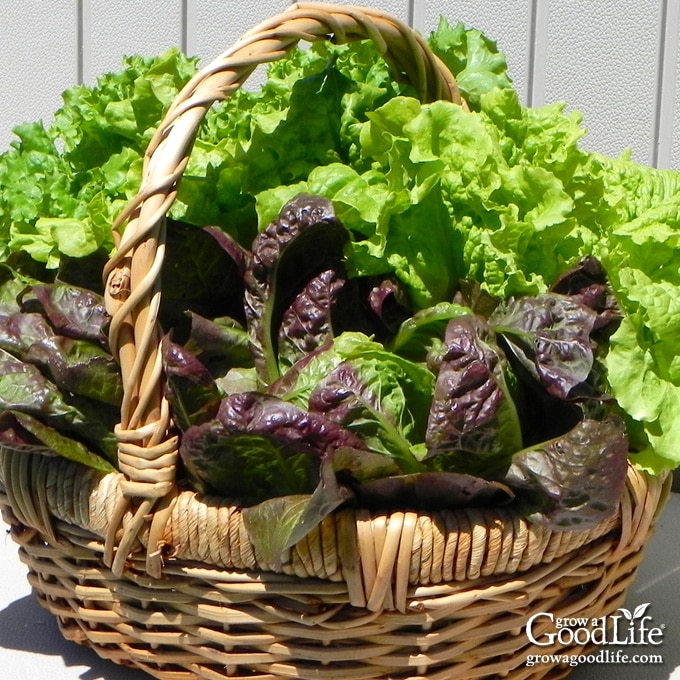
If you enjoy salads, you’ll love growing your own lettuce. Unlike the bags of baby greens in your refrigerator, lettuce stays fresh longer until it is ready to harvest. The flavor of homegrown lettuce is much better too. In addition, you can plant lettuce in your vegetable garden, in containers, and even indoors for a continuous harvest of fresh greens.
Lettuce is the foundation of all your fresh green salads and an essential ingredient for Bacon, Lettuce, and Tomato sandwiches. Lettuce layered on a burger adds a nice, crisp crunch, and you can also use the leaves to make your homemade lettuce wraps.
About Lettuce
Lettuce (Lactuca sativa) is a cool-season crop native to the Mediterranean. It was first cultivated in ancient Egypt for the oil-rich seeds and then bred for its edible leaves.
Over the years, lettuce has become an established garden crop found worldwide. Ranging in various colors and sizes, we can all agree that lettuce is undoubtedly a staple in our lives.
Lettuce Varieties to Consider
There are four major types of lettuce: iceberg, butterhead, romaine, and loose leaf. Let’s break down each one:
Iceberg and Crisphead
Iceberg lettuce, also commonly known as crisphead lettuce, is the round light green heads you will find at the grocery store. This crunchy variety grows a firm circular head of thin crisp leaves with distinct cream-colored veins. Iceberg has a long growing season, taking 80 to 90 days to grow from seed to harvest. Crisphead lettuce varieties include Crispino, Great Lakes 118, Ithaca, and Imperial.
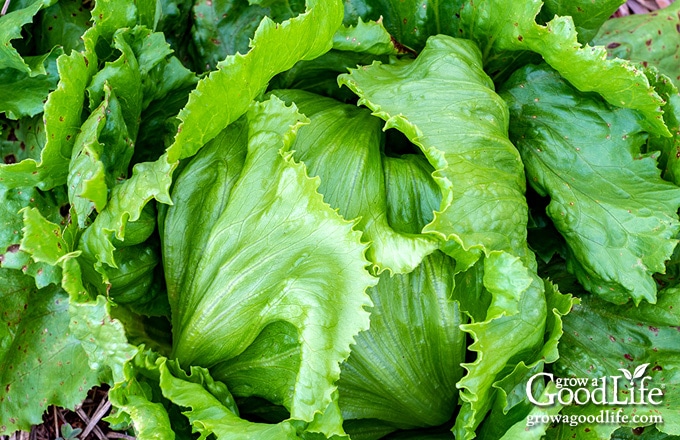
Butterhead and Bibb
Butterhead, also called bibb lettuce, forms a head like iceberg. However, the texture is much looser, and the leaves don’t have prominent veins. As a result, the flavor of the foliage is more delicate. Plant bibb lettuce in early spring, and you can harvest the loose, soft heads in 45 to 75 days, depending on the variety. Types of butterhead lettuce include Amish Speckled, Boston Bibb, Buttercrunch, and Merveille de Quatre Saisons.
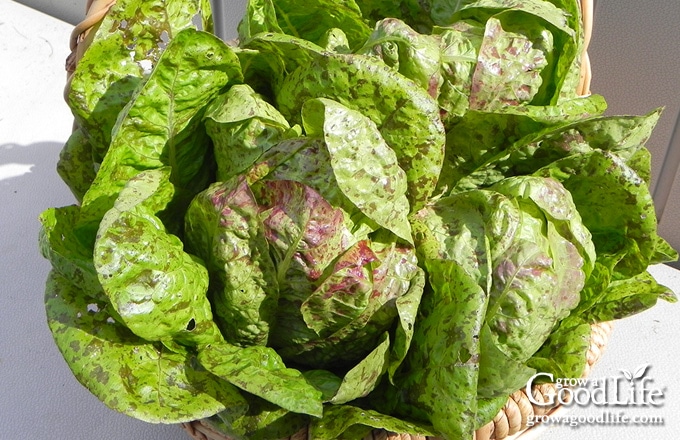
Romaine and Cos
Romaine lettuce, also called Cos lettuce, grows a long, narrow, upright head with long, loose leaves. Despite the coarse appearance, the texture of the foliage is very tender. This variety is the standard lettuce used in Caesar salads and is often sold in supermarkets as whole heads or stripped of its outer leaves and sold as Romaine lettuce hearts. Romaine lettuce matures in 65 to 70 days. Romaine varieties include Freckles, Jericho, Green Towers, Rouge D’Hiver, Parris Island Cos, and Red Romaine.
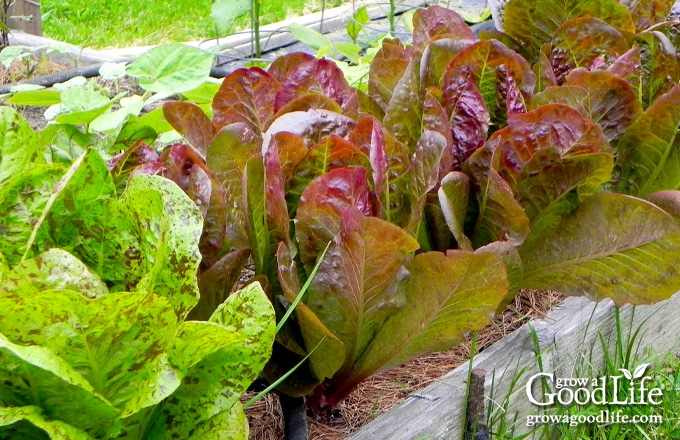
Leaf Lettuce or Loose Head
Leaf lettuce, also called looseleaf lettuce or loose head lettuce, doesn’t form heads. Instead, the foliage grows from the center outward, forming a leafy mound. The leaves may be frilly, curly, serrated, or wrinkled, depending on the variety.
If you harvest leaves from the outside, the plant will resume growing from the center for a continuous harvest. Loose leaf types mature in 45 to 50 days. Varieties of leaf lettuce include Black Seeded Simpson, Lollo Rossa, Red Oak Leaf, and Tango.
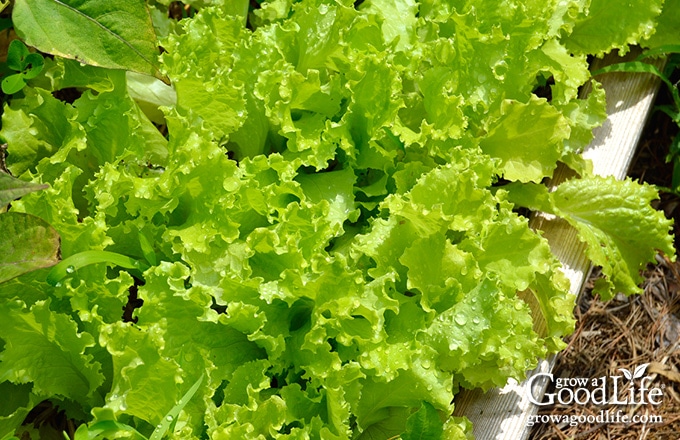
Lettuce Blends
In addition, many seed companies create a mix of lettuce called Mesclun lettuce, baby greens, or cut-and-come-again lettuce. These are just a combination of lettuce types and other greens that are grouped together with similar growing needs. They are harvested as baby greens in 2 to 4 weeks or cut-and-come-again lettuce once they reach about 6-inches high.
Tips for Growing Lettuce
Lettuce is easy to grow and thrives in full sun or partial shade. It grows quickly and takes up very little space making it ideal for raised beds, containers, or even window boxes. All lettuce varieties can be harvested early as baby greens or left to mature fully. Follow these easy tips to learn how to grow lettuce in your own home.
When to Grow Lettuce
Lettuce is a cool-season crop that can tolerate light frosts. Therefore, plan to grow lettuce during the cool gardening seasons of spring and fall.
The time to start seeds will depend on your last estimated frost date for your area. You can find your last frost date by contacting your local extension office (search for “extension office near me”) or enter your zip code here at PlantMaps.com.
Direct sow lettuce seeds in early spring after the danger of heavy frost is past, or start lettuce seeds indoors 4 weeks before your last frost date. Transplant hardened-off seedlings to the garden after your last frost date, and sow every two weeks to extend your harvest until the summer heat arrives.
While some established plants tolerate warm temperatures, the summer heat can turn your leaves bitter and trigger your lettuce to bolt and go to seed. A sure sign of bolting is when your lettuce grows a tall leafy stalk from the center of the plant. The foliage is still safe to eat, but the flavor eventually turns bitter. It is best to pull the bolted lettuce plants and sow something else, such as bush beans or carrots.
Plant lettuce in the late summer for an early fall harvest. Lettuce seeds won’t germinate if the soil temperature is above 80˚F. If the weather is still warm, start seeds indoors under lights and transplant seedlings once the weather cools.
How to Prepare the Garden Bed
Choose a spot that receives at least 6 hours of sun each day. The ideal soil type for lettuce is light, rich in organic material, and has good drainage. Aim for soil that has a neutral pH level between 6.0 and 7.0.
Prepare the garden bed as soon as the ground can be worked by removing all weeds and leftover plant debris. Next, add about 2 inches of aged compost to your soil, and work it in about 6 to 8 inches deep. As you work the soil, pick out any stones and twigs, and break up large clumps.
If the weather has been dry, prepare and water the bed well the day before you sow seeds or transplant seedlings.
How to Plant Lettuce
You can start lettuce seeds indoors under grow lights, purchase transplants from a garden center or greenhouse, or direct sow seeds in the garden. Seeds take about 7 to 10 days to sprout and germinate best at a soil temperature between 55˚F to 65˚F.
Each type of lettuce has different spacing needs. Check the back of your seed package for the recommended spacing requirements. Generally, space iceberg 16 inches, butterhead and romaine about 8 inches, and loose leaf varieties 4 inches apart. In addition, each row of lettuce should be spaced 12 to 15 inches apart, regardless of type.
Starting Lettuce Seeds Indoors
Start lettuce seedlings indoors 4 weeks before your last frost date. Fill your containers with damp seed starting mix to within 1/2-inch of the top of the container. Sow several lettuce seeds on top of the soil, then cover with a light dusting of the potting mix.
Mist the soil surface with water, and cover the containers with a humidity dome to keep in moisture. Place the trays under lights in a warm location or use a seedling heat mat for quicker germination. Be sure to harden off your seedlings and then transplant outdoors once the soil warms and after all danger of frost is past. Learn more: How to Start Seeds Indoors.
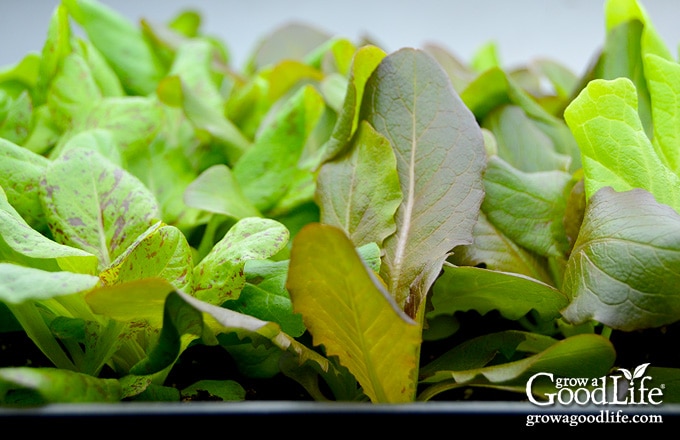
Transplanting Seedlings
If you grow seedlings indoors or purchase transplants from a warm greenhouse, they will need to be hardened off to adjust to the environment outdoors. The hardening-off period allows your seedling to transition from the comfortable growing conditions under lights to the normal conditions they will experience in the garden. Learn How to Harden Off Seedlings with this step-by-step tutorial.

After your seedlings are hardened off, they are ready to be transplanted into their permanent location in the garden. Prepare your garden beds ahead of time. If the weather has been dry, water the bed thoroughly the day before you plant.
Choose a cloudy day with no wind and transplant in the late afternoon or evening to give your plants time to adjust without the additional challenge of the sun. Water the seedlings well after planting. Lettuce plants that are sufficiently hardened off will survive light frosts.
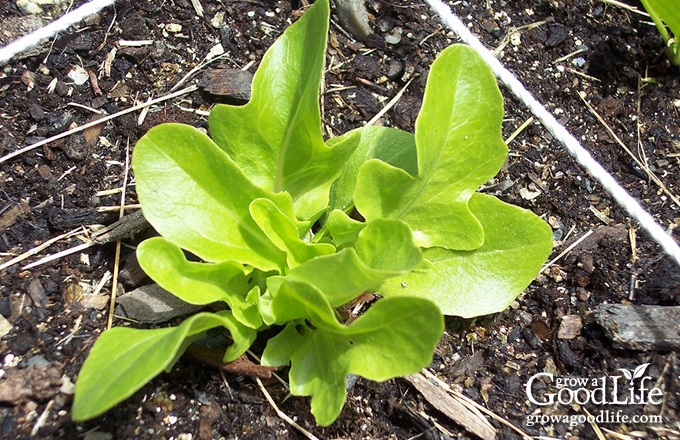
Direct Sowing Seeds
You can plant lettuce once the soil temperature exceeds 40˚F, but seeds germinate best at 55 to 65˚F. Therefore, direct sow in early spring after the danger of heavy frost is past, and the ground has dried.
Prepare the garden ahead of time, and sow your seeds in shallow, damp soil, about 1/8 to 1/4 inch deep. Lettuce seeds need sunlight to germinate, so it is important to plant them with just enough covering to keep the seeds moist.
Lettuce seeds are tiny and can be difficult to space out correctly. You can broadcast sow the seeds on the soil’s surface, cover them with a light layer of potting mix, and then thin the plants later. Or consider creating homemade seed mats to space the seeds evenly and eliminate thinning later.
With the right conditions, it should only take a few days for you to see sprouts growing from the soil. When the seedlings are 1 to 2 inches tall, it is time to thin your seedlings to space them properly. Snip the plants at the soil surface, and add the thinnings to salads.
Succession Sowing to Extend Harvests
Lettuce is a fairly fast-growing crop, and is a great candidate for succession planting. Succession planting is when you stagger sow your seeds instead of planting them all at once.
Two weeks after sowing the initial planting of lettuce, plant another batch of seeds, and repeat until the weather warms. Succession sowing will help you stagger your harvests so you won’t be overwhelmed with a surplus of mature lettuce at one time.
How to Care for the Plants
Lettuce is easy to grow and requires very little care once the plants are established. Here are some tips to keep your plants healthy and thriving:
Watering
Lettuce’s roots are shallow, so make sure your plants receive consistent water, either by rain or hand watering. Check the soil moisture twice a week by poking your finger about 1-inch deep. If the soil is dry, give your plants a good watering.
Maintaining an even level of moisture is very important when it comes to growing lettuce. You want to ensure your soil is consistently moist but not soaked with water. Keeping your soil moist helps maintain a cool temperature, prevent bolting, and preserve the quality of the foliage.
Water your plants in the morning or early afternoon. Try your best to avoid wetting the leaves, as this will open them up to the possibility of fungal disease. Instead, use drip irrigation, a soaker hose, or water by hand to deliver water to the base of the plants.
Mulching the Soil
Add several inches of organic mulch, such as straw or shredded leaves on top of the soil while keeping it a few inches away from the plants. Mulch provides many benefits to your garden, including weed suppression, moisture retention, temperature control, and pest prevention.
Keeping Up with the Weeds
Weed around your lettuce carefully by hand. Please remember that lettuce has shallow, delicate roots; forcibly removing weeds can damage this root system. Instead, try pulling weeds after a good watering or rain storm. The moist soil will help the roots slide right out of the ground.
Fertilizing
You are off to a good start if you worked in finished compost when you prepared the garden beds for planting. Your lettuce will have a decent amount of nutrients from the compost to grow into healthy plants. Leaf lettuce will not need any additional fertilizer, but heading lettuce will benefit significantly from a second round of feeding halfway into its growing period.
Three weeks after planting heading lettuce, apply a balanced organic fertilizer, or one high in nitrogen to help encourage strong foliage growth. Always follow the instructions on the package to avoid accidentally damaging your plants.
Troubleshooting Pests and Diseases
Lettuce is easy to grow, and as long as you provide good soil, sunlight, and nutrition, you will grow healthy pants. However, like any other crop, lettuce can be susceptible to some pests and diseases. Therefore, give your plants a weekly inspection for signs of trouble.
Common pests that affect lettuce include aphids, beetles, caterpillars, cutworms, leaf miners, slugs, and snails. These pests like to hide, often underneath leaves or in the crevices in your lettuce heads.
Some fungal diseases, such as powdery mildew, downy mildew, and leaf spot, take hold under a combination of humid conditions, wet foliage, and a lack of air circulation.
To help prevent fungal diseases, grow your lettuce in partial sun or full sunlight and properly space the plants so they are not overcrowded. Mulch and water close to the base of the plant to reduce the risk of wet foliage, and prune any foliage with mildew on it and destroy it.
- Aphids are tiny insects that congregate in clusters on lettuce leaves. They are sap-sucking insects, meaning they suck out the nutrients from your plant, causing the leaves to look wilted. You can easily dislodge aphids from your plants by hosing them down with a jet stream of cool water.
- Caterpillars and worms come from butterflies and moths laying eggs on the foliage. After hatching, the caterpillars feed on lettuce until they form a cocoon. Hand-pick frequently, toss a jar of soapy water, and use row covers to prevent the moths from laying eggs.
- Slugs and Snails love to turn your lettuce into their dinner. Luckily, there are some very effective methods of controlling them. Putting down a layer of crushed eggshells is extremely helpful in deterring these pests from reaching your plants. You can also hand-pick them off your plants and toss them out of the garden.
- Powdery Mildew is a fungal disease that gets its name from the powder-like fungus that coats the leaves. If you find powdery mildew on your lettuce, it is important to act quickly, as this mildew is known to spread rapidly from plant to plant. Prune any affected foliage and dispose of it entirely- do not compost any infected plants.
Tips for Growing Lettuce in Summer
Since lettuce is a cool-season crop that tends to bolt in hot weather, and tomatoes, cucumbers, and peppers are warm-season crops, it can be challenging to have lettuce available for harvesting at the same time for salads.
It took me a while to figure out how to grow summer lettuce. Here are tips to keep lettuce producing when it gets hot:
Grow heat tolerant lettuce varieties
Some lettuce varieties are slow to bolt and turn bitter in the heat. Types of heat-tolerant lettuces include:
- Iceberg: Great Lakes 118
- Butterhead: Ice Queen, Magenta, and Marvel of Four Seasons
- Romaine: Jericho, Little Gem, Parris Island Cos, and Rouge d’ Hiver
- Leaf Lettuce: Black Seeded Simpson, New Red Fire, Red Oak Leaf, Red Sails, and Salad Bowl Blend
Establish plants before the heat arrives
Mature plants have a more robust root system allowing them to soak up moisture and nutrition more efficiently. In addition, the leaves are plumper to help hold up to heat. Since lettuce seeds will not germinate once the soil temperature is over 80˚F, start seeds indoors, transplant healthy seedlings during a cool period, water well until the plants become established, and provide plenty of water during hot temperatures.
Plant in shade
Growing lettuce beneath a trellis of vining plants provides a canopy of dappled shade that helps keep the plants cooler. You can also use shade cloths or grow lettuce in containers that you can move into the shade during a hot spell. Also see 30 Vegetables that Grow in Partial Shade for additional tips for growing vegetables in shade.
Water As Needed
Give the plants extra attention during hot spells. Water the plants regularly to keep the soil evenly moist, use a mulch to help keep the soil cool and hold in moisture, and shade the plants from direct sunlight during hot days to help them stay healthy.
Growing Lettuce in Containers
Since their roots are shallow, lettuce can grow in various containers, from small pots to large tubs. Growing a container vegetable garden is an excellent option if you don’t have a lot of space for a traditional garden.
Another advantage to growing lettuce in pots is it is easy to move the containers to shade in the afternoon to protect the plants from the heat.
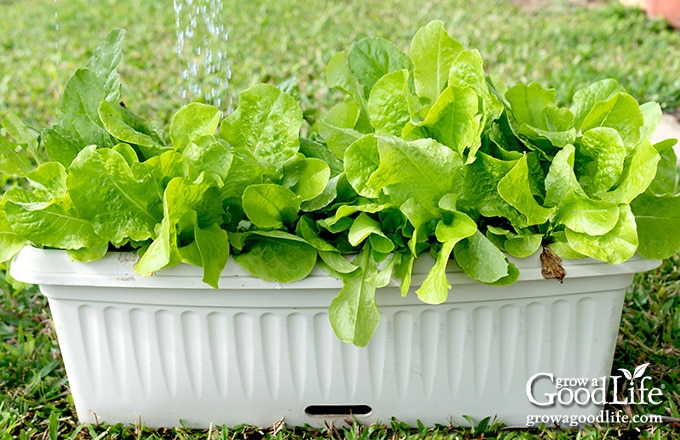
Window boxes at least 6-inches deep that hold 1 to 3 gallons of potting mix are ideal for growing several lettuce plants. While larger pots are a great choice if you want to grow more than one type of lettuce at a time or interplant with other crops.
Use a good-quality potting mix suitable for growing vegetables in containers. Mix in a balanced slow-release organic fertilizer if your potting soil doesn’t contain fertilizer. Hydrate the soil by letting it soak for several hours, and fill the pot once the soil is evenly damp.
Sow seeds or transplant seedlings, and water in well. Keep the soil evenly moist until the plants become established, and then let the soil dry out a bit in between, watering only when the top inch of the soil is dry.
A feeding every 2 weeks with a balanced organic liquid fertilizer such as fish and seaweed emulsion will keep your plants nourished. Thin and harvest your lettuce once the leaves reach a usable size, and sow more seeds every 2 weeks.
How to Grow Lettuce Indoors
Growing lettuce indoors is a great way to have plenty of greens for winter salads and sandwiches at your fingertips. I love growing leafy greens under lights in my basement all winter long. Since lettuce is a cool-season crop, it will also grow well on a south-facing windowsill that may get chilly at night.
Choose pots or containers that are about 6 to 8-inches deep, and fill them with a damp potting mix suitable for containers. Mix in a balanced slow release organic fertilizer, and sow your seeds. Water the plants regularly, thin as needed, and wait until the lettuce leaves are big enough to harvest.
Harvesting Lettuce
One thing that makes lettuce such an easy crop to grow is harvest time. You can pick lettuce at any size you prefer. However, make sure to harvest your lettuce before the head begins to elongate (a sign of bolting). Lettuce harvested too late tends to taste bitter.
Lettuce is ready to harvest within 30 to 80 days after planting. You can harvest tender baby greens and looseleaf lettuce in as little as 30 days. Let heading lettuce mature and harvest the whole plant at once in about 60 to 90 days, depending on the variety.
For optimum flavor and texture, harvest lettuce in the morning once the dew has evaporated from the foliage. The heat and sun can stress your plants and cause the leaves to wilt.
Use a knife or scissors to harvest and leave a clean cut. You can harvest by cutting the entire head of lettuce off at the ground level or clipping a few leaves at a time. Harvest the leaves on the outside of the plant, and it will continue to grow and produce more foliage from the center.
You may see the term “cut and come again lettuce” on your seed packages. This term is used when you can harvest part of the plant, and the plant continues to grow and produce more foliage for more extended harvests. For example, if you cut the plant and leave about 2-inches, the plant will re-grow from the stump.
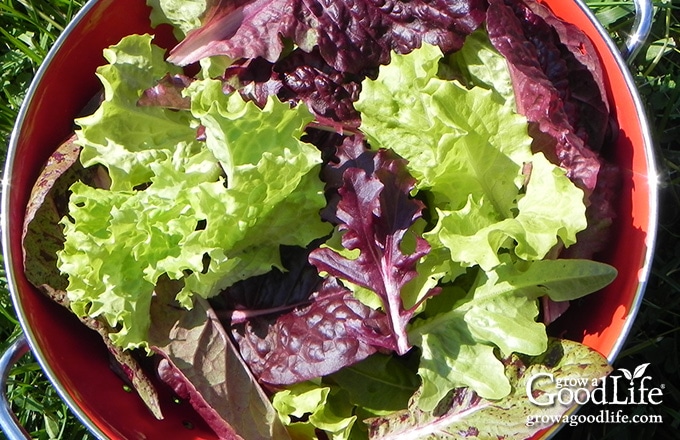
You can store lettuce in loosely wrapped plastic bags. They should last about 10 days in the refrigerator. If you’ve noticed your lettuce has started to wilt, you can perk it back to normal by soaking the leaves in ice water for 15 minutes.
—
Whether you plant lettuce outside in the garden, in containers on your patio, or even indoors on a sunny windowsill, I hope these tips help you grow a continuous supply of homegrown lettuce ready to harvest at any time.
You May Also Like the Following:
- 30 Vegetables that Grow in Partial Shade
- 13 Quick Growing Cool Season Crops for Fall Planting
- How to Grow Spinach
- How to Grow Swiss Chard
Good planning is key to a successful vegetable garden
Whether you are new to growing your own food or have been growing a vegetable garden for years, you will benefit from some planning each year. You will find everything you need to organize and plan your vegetable garden in my PDF eBook, Grow a Good Life Guide to Planning Your Vegetable Garden.

